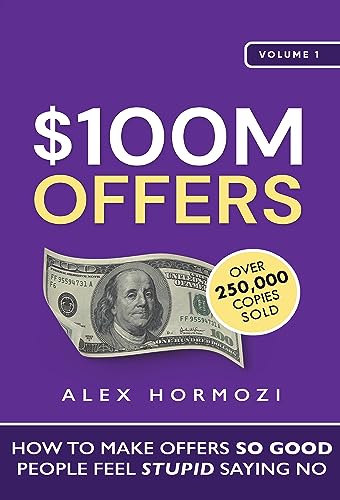In $100M Offers: How To Make Offers So Good People Feel Stupid Saying No, entrepreneur Alex Hormozi shares strategies for crafting an irresistible profitable offer and how to turn advertising dollars into (enormous) profits using a combination of pricing, value, guarantees, and naming strategies. The Grand Slam Offer as Alex calls it, would make people feel stupid saying no.
What’s An Offer?
The only way to conduct business is through a value exchange, a trade of dollars for value. The offer is what initiates this trade. In a nutshell, the offer is the goods and services you agree to give or provide, how you accept payment, and the terms of the agreement. It is what begins the process of getting customers and making money. It is the first thing any new customer will interact with in your business. Since the offer is what attracts new customers, it is the lifeblood of your business. No offer? No business. No life. Bad offer? Negative profit. No business. Miserable life.
Commoditized = Price Driven Purchases (race to the bottom), Differentiated = Value Driven Purchases (sell in a category of one with no comparison.
PRICING: THE COMMODITY PROBLEM
A commodity is a product available from many places. For that reason, it’s prone to purchases based on “price” instead of “value.” If all products are “equal,” then the cheapest one is the most valuable by default. In other words, if a prospect compares your product to another and thinks “these are pretty much the same, I’ll buy the cheaper one,” then they commoditized you.
The Grand Slam Offer
Grand Slam Offer.
It’s an offer you present to the marketplace that cannot be compared to any other product or service available, combining an attractive promotion, an unmatchable value proposition, a premium price, and an unbeatable guarantee with a money model (payment terms) that allows you to get paid to get new customers . . . forever removing the cash constraint on business growth. In other words, it allows you to sell in a “category of one,” or, to apply another great phrase, to “sell in a vacuum.” The resulting purchasing decision for the prospect is now between your product and nothing. So you can sell at whatever price you get the prospect to perceive, not in comparison to anything else. As a result, it gets you more customers, at higher ticket prices, for less money. If you like fancy marketing terms, it breaks down like this:
Increased Response Rates (think clicks) Increased Conversion (think sales), Premium Prices (think charging a lot of money).
A Normal Market
A market that is growing at the same rate as the marketplace and that has common unmet needs that fall into one of three categories: improved health, increased wealth, or improved relationships.
There are three main markets that will always exist: Health, Wealth, and Relationships. The reason that those will always exist is that there is always tremendous pain when you lack them. There is always demand for solutions to these core human pains. The goal is to find a smaller subgroup within one of those larger buckets that is growing, has the buying power, and is easy to target (the other three variables).
There are three main markets that will always exist: Health, Wealth, and Relationships.
Massive Pain
They must not want, but desperately need, what I am offering. Pain can be anything that frustrates people about their lives. Being broke is painful. A bad marriage is painful. Waiting in line at the grocery stores is painful. Back pain . . . ugly smile pain . . . overweight pain. Humans suffer a lot. So for us entrepreneurs, endless opportunity abounds. The degree of the pain will be proportional to the price you will be able to charge. When they hear the solution to their pain, and inversely, what their life would look like without this pain, they should be drawn to your solution.
“The pain is the pitch.” If you can articulate the pain a prospect is feeling accurately, they will almost always buy what you are offering. A prospect must have a painful problem for us to solve and charge money for our solution.
Purchasing Power
Your audience needs to be able to afford the service you’re charging them for. Make sure your targets have the money, or access to the amount of money, needed to buy your services at the prices you require to make it worth your time.
Easy to Target
This point is tactical. It is reality, not theoretical. For instance, you may want to serve rich doctors. But if your ads are being displayed to nursing students, your offer will fall on deaf ears, no matter how good it is. Main point: you want to make sure you can target your ideal audience easily.
Growing
Growing markets are like a tailwind. They make everything move forward faster. Declining markers are like headwinds. They make all efforts harder. Business is hard enough, and markets move quickly. So you might as well find a good market to give you a tailwind to make the process easier.
Starving Crowd (market) > Offer Strength > Persuasion Skills
Order of Importance: Three Levers on Success
First, don’t pick a bad market. Normal markets are fine. Great markets are great. Second, once you pick, commit to it until you figure it out. If you try one hundred offers, I promise you will succeed. Most people never try anything. Others fail once, then give up. It takes resilience to succeed. Stop personalizing! It’s not about you! If your offer doesn’t work, it doesn’t mean you suck. It means your offer sucks. Big difference. You only suck if you stop trying. So, try again. You’ll never become world-class if you stop after a failed attempt.
“Charge as high a price as you can say out loud without cracking a smile.” – DAN KENNEDY
Price to Value Discrepancy
In order to understand how to make a compelling offer, you must understand value. The reason people buy anything is to get a deal. They believe what they are getting (VALUE) is worth more than what they are giving in exchange for it (PRICE). The moment the value they receive dips below what they are paying, they stop buying from you. This price-to-value discrepancy is what you need to avoid at all costs.
“Price is what you pay. Value is what you get.” – Warren Buffet
Don’t Compete on Price
Getting people to buy is NOT the objective of a business. Making money is. And lowering price is a one-way road to destruction for most — you can only go down to $0, but you can go infinitely high in the other direction. So, unless you have a revolutionary way of decreasing your costs to 1/10th compared to your competition, don’t compete on price.
“There is no strategic benefit to being the second cheapest in the marketplace, but there is for being the most expensive.” – Dan Kennedy
Perception is reality.
It’s not about how much you increase your prospect’s likelihood of success, or decrease the time delay to achievement, or decrease their effort and sacrifice. That in itself is not valuable. Many times, they will have no idea. The Grand Slam Offer only becomes valuable once the prospect perceives the increase in likelihood of achievement, perceives the decrease in time delay, and perceives the decrease in effort and sacrifice.
The Value Equation.
There are four primary drivers of value. Two of the drivers (on top), you will seek to increase. The other two (on the bottom), you will seek to decrease.
- The Dream Outcome (Goal: Increase)
- Perceived Likelihood of Achievement (Goal: Increase)
- Perceived Time Delay Between Start and Achievement (Goal: Decrease)
- Perceived Effort & Sacrifice (Goal: Decrease)
#1 Dream Outcome (Goal = Increase)
People have deep, unchanging desires. This is what marriages are lost over, wars are fought over, and people will willingly die for. Our goal is not to create desire. It’s simply to channel that desire through our offer and monetization vehicle. The dream outcome is the expression of the feelings and experiences the prospect has envisioned in their mind. It’s the gap between their current reality and their dreams. Our goal is to accurately depict that dream back to them, so they feel understood, and explain how our vehicle will get them there.
#2 Perceived Likelihood of Achievement (Goal = Increase)
People pay for certainty. They value certainty. Increasing a prospect’s conviction that your offer will “actually” work for them, will make your offer that much more valuable even though the work remains the same on your end. So to increase value with all offers, we must communicate perceived likelihood of achievement through our messaging, proof, what we choose to include or exclude in our offer, and our guarantees.
Time Delay (Goal = Decrease)
Time delay is the time between a client buying and receiving the promised benefit. The shorter the distance between when they purchase and they receive value/the outcome, the more valuable your services or product is.
#4 Effort & Sacrifice (Goal = Decrease)
This is what it “costs” people in ancillary costs, aka “other costs accrued along the way.” These can be both tangible and intangible.
Decreasing the effort and sacrifice, or at least the perceived effort and sacrifice, can massively boost the appeal of your offer. In an ideal world, a prospect would want to simply “say yes” and have their dream outcome happen with no more effort on their behalf. This is why “done for you services” are almost always more expensive than “do-it-yourself” because the person doesn’t have all the effort and sacrifice.
All the best in your quest to get better. Don’t Settle: Live with Passion;



Comments are closed.